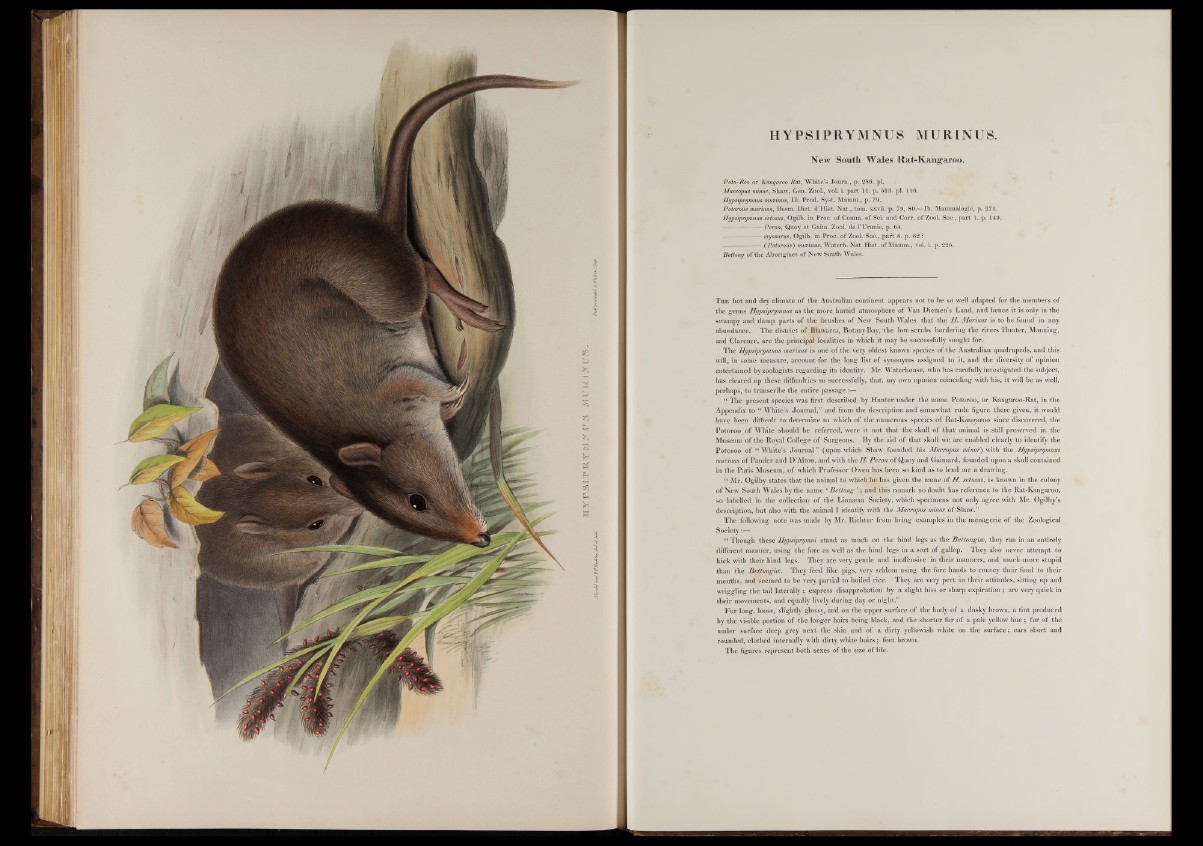
H x r s i i i R i r s t r s ' i i T S u — —
HYPSIPRYMNUS MURINUS.
New South Wales Rat-Kangaroo.
Poto-Roo or Kangaroo Rat, White’s Joum., p. 286. pi.
Macropus minor, Shaw, Gen. Zool., vol. i. part 11. p. 513. pi. 116.
Hypsiprymnus murinus, 111. Prod. Syst. Mamm., p. 79.
Potoroiis murinus, Desm. Diet. d’Hist. Nat., tom. xxvii. p. 79, 80.—lb. Mammalogie, p. 271.
Hypsiprymnus setosus, Ogilb. in Proc. of Comm, of Sci. and Corr. of Zool. Soc., part 1. p. 149.
-----------------Peron, Quoy et Gaim. Zool. de l’Uranie, p. 64.
myosurus, Ogilb. in Proc. of Zool. Soc., part 6. p. 62 ?
----------------- (Potoroiis) murinus, Waterh. Nat. Hist, of Mamm., vol. i. p. 225.
Bettong of the Aborigines of New South Wales.
T he hot and dry climate of the Australian continent appears not to be so well adapted for the members of
the genus Hypsiprymnus as the more humid atmosphere of Van Diemen’s Land, and hence it is only in the
swampy and damp parts of the brushes of New South Wales that the H. Murinus is to be fouud in any
abundance. The district of Illawarra, Botany Bay, the low scrubs bordering the rivers Hunter, Manning,
and Clarence, are the principal localities in which it may be successfully sought for.
The Hypsiprymnus murinus is one of the very oldest known species of the Australian quadrupeds, and this
will, in some measure, account for the long list of synonyms assigned to it, and the diversity of opinion
entertained by zoologists regarding its identity. Mr. Waterhouse, who has carefully investigated the subject,
has cleared up these difficulties so successfully, that, my own opinion coinciding with his, it will be as well,
perhaps, to transcribe the entire passage :—
“ The present species was first described by Hunter under the name Potoroo, or Kangaroo-Rat, in the
Appendix to “ White’s Journal,” and from the description and somewhat rude figure there given, it would
have been difficult to determine to which of the numerous species of Rat-Kangaroo since discovered, the
Potoroo of White'should be referred, were it not that the skull of that animal is still preserved in the
Museum of the Royal College of Surgeons. By the aid of that skull we are enabled clearly to identify the
Potoroo of “ White’s Journal ” (upon which Shaw founded his Macropus minor) with the Hypsiprymnus
murinus of Pauder and D’Alton, and with the H. Peron of Quoy and Gaimard, founded upon a skull contained
in the Paris Museum, of which Professor Owen has been so kind as to lend me a drawing.
“ Mr. Ogilby states that the animal to which he has given the name of H setosus, is known in the colony
of New South Wales by the name ‘ Bettong ’ ; and this remark no doubt has reference to the Rat-Kangaroo,
so labelled in the collection of the Linnsean Society, which specimens not only agree with Mr. Ogilby’s
description, but also with the animal I identify with the Macropus minor of Shaw.”
The following note was made by Mr. Richter from living examples in the menagerie of the Zoological
Society
“ Though these Hypsiprymni stand as much on the hind legs as the Bettongice, they run in.an entirely
different manner, using the fore as well as the hind legs in a sort of gallop. They also never attempt to
kick with their hind legs. They are very gentle and inoffensive in their manners, and much more stupid
than the Bettongice. They feed like pigs, very seldom using the fore hands to convey their food to their
mouths, and seemed to be very partial to boiled rice. They are very pert in their attitudes, sitting up and
wriggling the tail laterally ; express disapprobation by a slight hiss or sharp expiration ; are very quick in
their movements, and equally lively during day or night.”
Fur long, loose, slightly glossy, and on the upper surface of the body of a dusky brown, a tint produced
by the visible portion of the longer hairs being black, and the shorter fur of a pale yellow Hue; fur of the
under surface deep grey next the skin and of a dirty yellowish white on the surface; ears short and
rounded, clothed internally with dirty white hairs; feet brown.
The figures represent both sexes of the size of life.